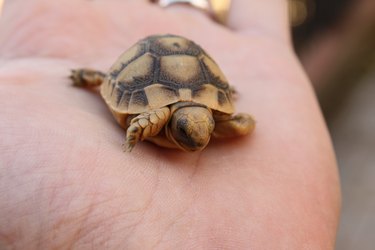A sulcata tortoise, also known as a spur thigh tortoise or an African spurred tortoise, is one of the largest tortoise species in the world. Of course, you want to know whether you have a boy or girl tortoise, especially if you get more than one, but you won't be able to determine the sex of your baby sulcata tortoise until it has grown to at least 10 to 15 pounds.

Video of the Day
Baby sulcata tortoise sex determination
It is nearly impossible to determine the sex of newly hatched sulcata tortoises. At this age, male and female baby sulcata tortoises appear identical. Sulcata tortoise sex determination is unique and depends on egg incubation temperature and weather. Females require warmer temperatures, and eggs incubated at a warmer temperature are more likely to be female. Warmer temperatures after hatching also increase the likelihood that the tortoises will be female. However, the temperature of egg incubation is not sufficient to confidently determine sex.
Video of the Day
Boy or girl tortoise characteristics
Once your baby sulcata tortoise reaches 10 to 15 pounds, there will be noticeable differences in appearance between males and females. Both genders have a brown outer shell, or carapace, and a front shell, or plastron, that is yellowish in color. They have large scales on their front legs and two or three spurs on their hind legs. Male tortoises tend to be larger than females, although this can be difficult to evaluate while babies are still growing.
To see the difference between males and females, look at the tortoise's tail and underside. Male tortoises have a long tail with a spur on the end, while females have a shorter, blunt tail. Next, take a look at the plastron. On a male, the plastron will be concave, while a female has a flat plastron. Finally, look at the anal scutes. On a male, these scutes will form a wide "V" shape. On a female, the scutes form more of a "U" shape that results in a larger opening that will allow the tortoise to lay eggs.
Male vs. female tortoise behavior
Certain behaviors can also indicate sulcata tortoise sex, although they shouldn't be used as your sole method of deciding whether you have a male or female tortoise. Your baby tortoise may not display these behaviors, but they will become more apparent as your tortoise reaches maturity.
Sulcata tortoises can be aggressive, and this is especially true if you have two mating males. Male tortoises will bite and ram each other. Females will also display these behaviors and will also drop their shells on the ground to create a thumping noise or throw the hind shell around. They also make a croaking sound.
About sulcata tortoises
Sulcata tortoises are native to central and northern Africa. When fully grown, they reach 26 to 36 inches tall and weigh up to 110 pounds. Initially, baby sulcata tortoises grow quickly and reach 7 pounds after two years, but it can take up to 20 years for them to reach their full size. They live 30 to 50 years, although with proper care in captivity, they may live up to 100 years.
For the first few years, you can keep your tortoise in a terrarium, but due to their large size, they do best in an outdoor enclosure where they can dig a burrow. Make sure it is secure, as they have been known to dig under fences.